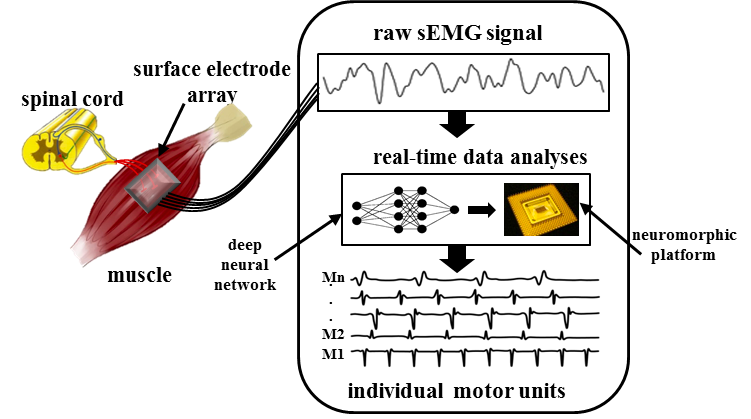Navigation auf uzh.ch
Navigation auf uzh.ch
The NEPSpiNN aims to realize a neuromorphic event-based neural processing system that can directly interface with commercial surface EMG for the extraction of signal features and classification of the hand-gesture. We propose an sEMG analysis stage, implemented in a compact ultra-low power neuromorphic chip, to be able to process data in real-time with low-latency.

The EMG is a non-invasive method for measuring the electrical activity, associated with muscle activities. The signals produced can be used to extract information about desired movements of the subjects under investigation and, in the context of rehabilitation, to control artificial systems for augmenting the ability of the subject. To understand muscular activation, it is necessary to monitor the electrical activity of a large number of individual muscles (and motorneurons) simultaneously. This results in a consistent number of EMG signals to process. Typically, the data are transmitted via Bluetooth to remote systems that are heavy and bulky, making a wearable solution complicated.
In NEPSpiNN, for the first time, we are making use of a mixed analog-digital neuromorphic event-based neural processing system to analyze EMG, through a full-custom hardware implementation of a spiking neural network.
During the project development, we implemented different spiking neural networks to investigate the best implementation considering some design constraints, such as the classification time, dimension of the network and power consumption. We investigated the recurrent spiking neural network, such as the liquid state network for implementing an on-chip memory and feedforward spiking network, as the spiking extreme learning machine. Such a network can classify hand-gesture within 200 ms, the time required in prosthetics control with extremely low power consumption, an order of tens of uW.
With the scope of low-cost personalized medicine for upper limb prosthetic training/calibration, we implemented a mobile application (for Android phone) that can fuse inputs from the EMG and an event-based camera to perform hand-gesture classification. The app uses spiking inputs but it performs the classification using standard machine learning methods, as the SVM and CNN. The network runs on the phone in 12ms with a real-time classification around 85%.
Ceolini, Enea, Gemma Taverni, Lyes Khacef, Melika Payvand, and Elisa Donati. "Sensor fusion using EMG and vision for hand gesture classification in mobile applications." arXiv preprint arXiv:1910.11126 (2019) https://arxiv.org/pdf/1910.11126.pdf
Donati, Elisa, Melika Payvand, Nicoletta Risi, Renate Barbara Krause, and Giacomo Indiveri. "Discrimination of EMG Signals Using a Neuromorphic Implementation of a Spiking Neural Network." IEEE transactions on biomedical circuits and systems (2019) https://ieeexplore.ieee.org/iel7/4156126/4358093/08747378.pdf
Donati, Elisa, Melika Payvand, Nicoletta Risi, Renate Krause, Karla Burelo, Giacomo Indiveri, Thomas Dalgaty, and Elisa Vianello. "Processing EMG signals using reservoir computing on an event-based neuromorphic system." In 2018 IEEE Biomedical Circuits and Systems Conference (BioCAS), pp. 1-4. IEEE, 2018 https://ieeexplore.ieee.org/iel7/8572002/8584657/08584674.pdf
Donati, Elisa, Fernando Perez-Peña, Chiara Bartolozzi, Giacomo Indiveri, and Elisabetta Chicca. "Open-loop neuromorphic controller implemented on vlsi devices." In 2018 7th IEEE International Conference on Biomedical Robotics and Biomechatronics (Biorob), pp. 827-832. IEEE, 2018 https://ieeexplore.ieee.org/iel7/8472797/8487180/08487937.pdf